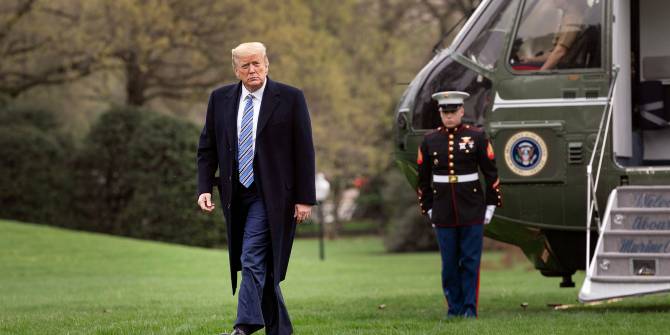In the last of our series on the challenges facing the World Trade Organisation, Ceylan Inan and Ira Poensgren (LSE) look at the tensions that have emerged between developed and developing countries as they try to agree how to treat each other. The definitions of ‘developed’ and ‘developing’ are contested, not least by the US, which particularly resents the benefits China and India enjoy through their continued status as developing nations.
Over the last 30 years, the distribution of power in the multilateral trading system has become increasingly diversified. In GATT years, it was not unusual for a small group of OECD countries (mainly the “Quad” consisting of Japan, the EU, the United States & Canada) to dictate the significant elements of any negotiating agenda. With rising economies like China, India and Brazil accounting for ever-larger shares of world trade, such a situation is unthinkable in today’s WTO.

This new dynamic has given rise to various new conflicts and debates. Perhaps the most contentious are questions regarding differentiation: how to accommodate the needs of developing countries, while ensuring that the costs of multilateralism are shared equitably.
The international trading regime acknowledges the need to support developing countries as they liberalise their economies and expose their sectors to global competition. In the WTO, all self-declared developing countries benefit from 155 “special and differential treatment” (S&DT) provisions embedded across various agreements, including higher levels of bound tariff rates, longer implementation periods and less stringent reporting and notification requirements, among others. Technically, the key to unlocking these features is available to everyone: WTO treaties don’t include any concrete criteria to identify a developing country, except for LDCs and net food-importing countries. While few members disregard the need to accommodate different levels of development and distinct challenges of LDCs in trade rules, the questions of how to define, designate and graduate a developing country remain unanswered.
How viable is differentiation right now?
Trading partners disagree on the ends S&DT provisions are meant to serve in developing economies, and critics argue there is little evidence they promote growth and development. Proponents of S&DT argue this is due to a series of shortcomings in the way in which differentiation is designed. Sectors in which developing countries possess a comparative advantage, like agriculture and textiles, remain among the most protected. Many of the S&DT provisions remain non-binding and based on generalised processes lacking defined targets where non-compliance cannot really be shown – for example, the obligation to review the “development impact” of a particular measure. Even when a detrimental effect can be shown, key agreements don’t specify the withdrawal, modification or remedy of the measure concerned.
More fundamentally, the prescription often does not match the patient. Flexibilities allowing subsidies and safeguards are not enough to promote or protect disadvantaged groups in developing countries. Some provisions, most notably the safeguard clause in the Agreement on Agriculture, have even ironically led to a situation of “reverse differentiation” where the existing flexibilities can in essence only be used by developed members of the WTO.
The debate: who wants what?
Developing countries in the WTO have therefore long argued that the existing S&DT provisions are (at best) insufficient. They fought fiercely and succeeded in including the strengthening of S&DT in the mandate of the Doha Development Round to make them more “precise, effective and operational”, but negotiations remain gridlocked. Nearly two decades later, developing members continue to demand greater policy space, better-targeted instruments and increased support to pursue unique development strategies, shield disadvantaged groups and calibrate their integration into the global economy. For them, proposals by developed members disavow them of the political commitment to the Doha mandate, and to development more generally.
Most developing members, including China and India, insist on centring the reform debate around the scope and depth of the S&DT provisions, and contend that self-designation is the most appropriate means of determining a country’s development needs. Recently some emerging markets voluntarily renounced their developing country privileges, either as a result of their enhanced economic status like South Korea or for political gains on other issues. Brazil, for instance, pledged to give up its developing country status in exchange for US support for the country’s OECD membership. Finally, smaller economies pursue varying strategies, including openness to schemes which position them closer to LDCs than China and India, given that the former can be expected to continue to benefit from S&DT.
On the other side of the debate, developed members refuse to deepen the preferential treatment without being able to control which parties qualify and for how long. They express concerns about giving members at different levels of development the same concessions – not without the support of some developing countries as well. According to developed countries, the inefficient resource allocation that results from the existing system of differentiation is what distorts the ability of SD&T to provide adequate support to those countries that need it the most. They have called on relatively advanced developing members to renounce their status and to take on their “fair share” of the cost of multilateralism. For developed countries, self-designation is too chaotic, and an institutionalised graduation mechanism is indispensable if S&DT is to enable all beneficiaries to become part of the multilateral trading system.
The issue then becomes the highly quarrelsome task of defining eligibility criteria under the consensus norm. In 2019, Washington proposed hard criteria (e.g. high income, the share of global trade, membership in the OECD or G20) to define what should not characterise a developing country. Striving to calm US concerns and preserve the rules-based multilateral trading system, the EU delivered concrete proposals and Canada convened the so-called Ottawa Group of diverse WTO members to scrutinise reform. While the members of this group share US concerns that the WTO must adapt to contemporary power dynamics, they propose a flexible, issue-based approach, rather than the generalised hard criteria proposed by the US.
Challenges
Finding a compromise in this network of conflicting interests faces three underlying challenges. The first is the fundamental disagreement over the nature of today’s development divide. For the US and the EU and other OECD economies, the binary North-South logic that underpinned negotiations in the GATT no longer reflects the contemporary reality where emerging markets are rapidly gaining market power. In contrast, developing countries argue that while their economic conditions may be more diversified today, the development gap nonetheless persists and continues to grow, citing their poor performance in per capita and human development indicators. It is therefore unclear what the WTO mandate should be on helping countries address their “development challenges”.
The second challenge is the question of how to accommodate China, which threatens the market power of industrialised countries and has a state-capitalist model that does not fit the vocabulary of liberal market economies. China’s ability to retain developing country status despite its unprecedented economic growth has upset the trade-off between developing and developed members. Beijing relinquished many S&DT provisions and made significant commitments exceeding those of developing countries (and sometimes those of developed countries) when it acceded to the WTO in 2001. Yet China also has a notoriously poor track record of compliance with its transparency and notification requirements, so doubts remain that these commitments are being fulfilled. The problem is that as long as China benefits from the same form of S&DT as other developing countries, it significantly raises the costs for developed members of conceding to demands for strengthening differentiation.
The third challenge is the lack of political will to find common ground by the United States. It is no secret that President Trump is highly critical of the WTO and willing to go to unprecedented lengths to block the system until the cards are reshuffled in his favour. The differentiation impasse is compounded by his administration’s broader agenda of rectifying “imbalances” embedded in multilateral institutions and bilateral trade relations. With the termination of US preferences for India and Turkey’s participation in its GSP programme and a continuing trade war with China, 2019 saw the US launch battles to pressure multiple targets to give up their developing country status. In a July 2019 memorandum, the White House declared that it would not tolerate the categorisation of countries as beneficiaries of the privileges if they do not fit its own proposed criteria.
Finding a way forward
Any potential solution to the first challenge has to strike a delicate balance between flexibility and strictness. The proposed solutions can be roughly sorted into country-based and issue-based approaches.
The problem with the former approach, as taken in the US proposal, is that negotiations will invariably centre on the criteria used to determine an overall development status. This risks repeating the inefficiency inherent to any form of generalisation (including self-designation) by overly simplifying the challenges involved in alleviating poverty. It fosters a gridlock where both sides cherry-pick criteria that either include and exclude particular states.
The latter approach, taken by the Ottawa Group, rests on the negotiation of differentiation principles for individual issue-areas. This shifts the focus away from blanket privileges and towards targeted remedies for specific developmental deficits, offering much more room for compromise. Developed economies could agree to such an approach if it provides a graduation mechanism that limits free-riding. Developing countries are likely to insist that, rather than having to prove their eligibility to access S&DT provisions, they are granted access until agreed upon graduation triggers are reached. What makes this solution unpalatable to some is the sheer complexity of such a negotiation, as both forms of differentiation and trigger levels have to be agreed upon on a case-by-case basis. However, substantive compromise seems possible.
Regarding the second challenge, it is true that the rapid rise of strong trade partners has created new hardships. In short, it seems unlikely that the US or the EU would agree to any solution that doesn’t impose new disciplines on emerging WTO members. In terms of different models of development, in the past the trading system has found creative ways to absorb cooperative countries with different often less liberal economic growth models. It remains remarkable that the awkward stranger of a different era, Japan, now appears as a signatory to trilateral declarations with the US and the EU, striving to contain growing competition from emerging markets.
It is unclear, however, how the third challenge can be overcome. Thus far, the Trump administration has rejected other countries’ reform proposals, both developing and developed. Washington further categorically refuses to engage in any discussion that couples China and India with continued development challenges. On a mission to “make trade more free, fair and reciprocal”, it remains unclear what compromise would suffice to assuage the White House’s concerns and catalyse the reform negotiations.
This post represents the views of the authors and not those of the Brexit blog, nor LSE. It is the fifth in a series looking at the challenges facing the WTO; the first post is here. It draws on an extensive simulation of WTO reform as part of an LSE International Relations Department masters course option in economic diplomacy.







Studying Globalisation through the Grenoble Ecole de Management, I find these remarks very interesting, however I am interested to know how the various trade regimes encourage actual locally owned and operated producers and not merely local arms of international conglomerates operating within developing countries.